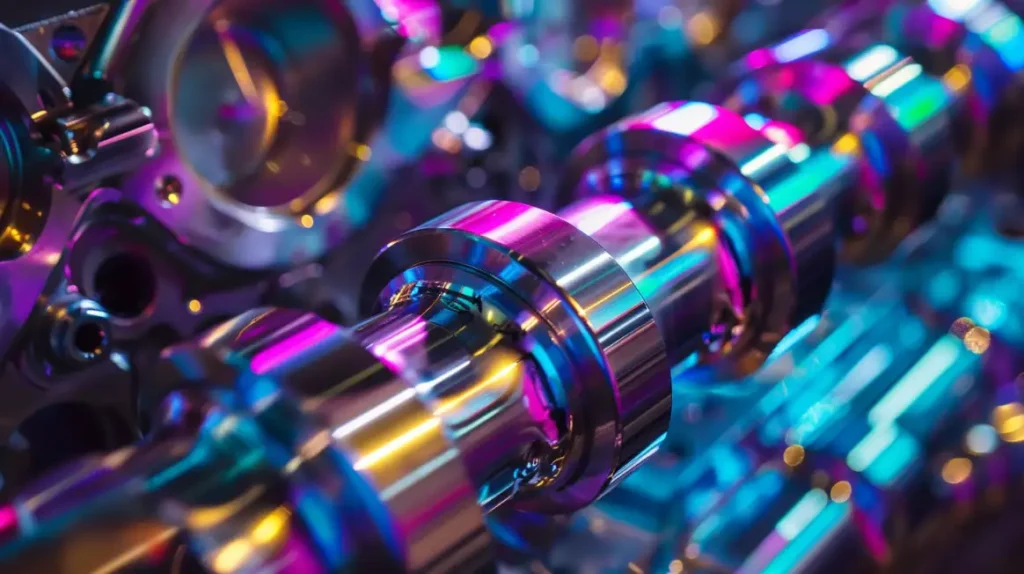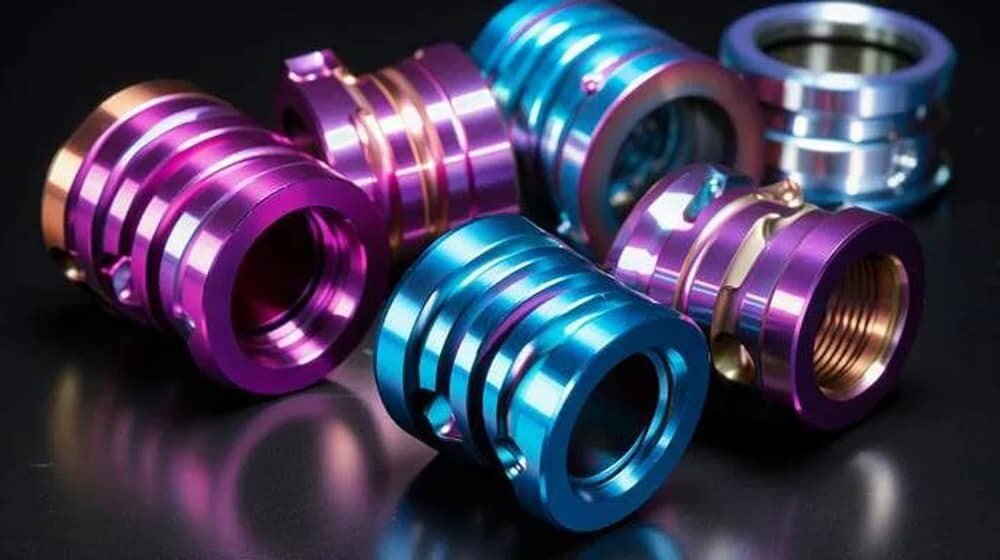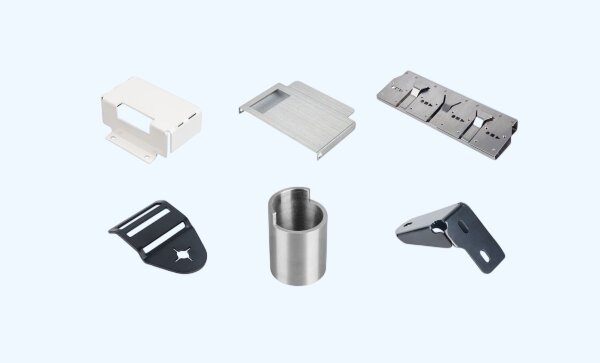Have you ever noticed titanium parts with bright, eye-catching colors and wondered how they got that way? Many engineers and buyers encounter difficulties when selecting the ideal surface finish for titanium. It’s not always easy to pick between different color options, processes, and uses. If you’re looking for more than just the usual gray finish, titanium anodizing could be the solution.
There’s a lot more to anodizing than just making things look nice. The process affects durability, function, and the applications where titanium parts can be used. This guide walks you through the science, the process, and the real-life uses for colored titanium.
What Is Titanium Anodizing?
Titanium anodizing is an electrochemical process. It changes the oxide layer on the surface of titanium. This layer controls how light reflects off the metal, creating different colors. The thicker the coating, the more the color shifts.
There are no pigments involved. The colors come from light interference, similar to how a soap bubble or oil film shows rainbow colors. The final result is vibrant, long-lasting, and doesn’t fade easily.
This process is commonly employed in the aerospace, medical, and consumer product industries. It gives parts a clean, modern look while offering some surface protection.
The Science Behind Titanium Anodizing
Titanium anodizing is more than a surface treatment. It’s a precise reaction between metal, electricity, and chemistry that creates consistent and repeatable results.
Electrochemical Reaction Explained
Titanium anodizing works by passing an electrical current through an electrolyte solution. The titanium acts as the anode. A cathode, typically made of stainless steel, completes the circuit. When voltage is applied, oxygen ions in the solution bond with the titanium surface.
This creates a layer of titanium oxide. Unlike rust on iron, this oxide layer is thin, controlled, and protective. It forms evenly and bonds tightly to the surface. There is no flaking or peeling.
The reaction doesn’t add anything to the surface. It modifies what’s already there. That’s why the result stays lightweight and doesn’t change the part’s size.
Role of Voltage and Electrolyte Composition
Voltage is the main factor that decides the final color. Each voltage level creates a different oxide thickness. For example, 15 volts may produce a gold color, while 110 volts might result in a blue or purple hue.
The electrolyte must be non-reactive with titanium. Common choices include trisodium phosphate (TSP), borax, or baking soda in water. These allow the oxide to form without damaging the surface.
The voltage must be precise. Even a small change can shift the color. That’s why high-quality anodizing uses controlled power supplies and clean, consistent solutions.
Color Generation and Thickness Correlation
Titanium colors don’t come from dyes or coatings. They come from light interference. When light hits the oxide layer, some of it reflects off the surface. Some passes through and reflects off the metal underneath. These two reflections overlap.
If the oxide layer is a specific thickness, the overlapping light waves cancel or amplify certain colors. This is the same effect seen in soap bubbles or butterfly wings.
Each thickness gives a different result. For example:
- 25 nm oxide = yellow
- 50 nm oxide = blue
- 70 nm oxide = purple
Types of Titanium Anodizing
Different anodizing methods offer different results. Some focus on surface protection, while others are made for bright color finishes.
Type 1: Chromic Acid Anodizing
This method uses chromic acid (typically around 10% by weight) as the electrolyte. It’s less aggressive than sulfuric or hydrofluoric acids. The oxide layer it forms is skinny, usually between 0.02 and 0.1 microns.
This layer enhances corrosion resistance and provides a suitable base for bonding or painting. But it doesn’t change the surface color. The finish remains a dull, matte gray.
Because the layer is thin, it doesn’t affect tight part tolerances. That’s why it’s widely used in aerospace and military applications, especially where paint or adhesives will be applied afterward. For example, aircraft fasteners, structural brackets, and titanium skins often undergo Type 1 anodizing before being painted.
Type 2: Sulfuric Acid Anodizing
Type 2 anodizing utilizes sulfuric acid in concentrations ranging from 15% to 20%, combined with a current density of approximately 1.0 to 1.5 A/dm². This produces a slightly thicker oxide layer, typically ranging from 0.5 to 2 microns, depending on the applied voltage and time.
This layer improves wear resistance more than chromic acid anodizing, but still does not create bright colors. The surface remains gray but becomes more rigid and more resistant to abrasion and corrosion.
It’s commonly used in industrial and structural components where durability is more important than appearance. You may see this in elements such as titanium heat exchangers, aerospace brackets, or chemical processing equipment.
Type 3: Color Anodizing (Thin-Film Interference)
Type 3 is the most recognized type for decorative finishes. It’s also known as thin-film interference anodizing. It doesn’t use dyes or paint. Instead, it builds a precise oxide layer on the surface, typically ranging from 30 to 180 nanometers in thickness.
The oxide layer creates color through light interference, similar to how soap bubbles display rainbow colors. As voltage increases, the oxide thickness grows, and the color shifts. Here’s a quick example:
| Voltage Range | Resulting Color |
|---|---|
| 15–18V | Light Gold |
| 25–27V | Purple |
| 30–32V | Deep Blue |
| 45–50V | Light Green |
| 70–75V | Bronze/Gray |
The voltage must be carefully controlled—just a ±1V shift can alter the final color. That’s why precision power supplies are critical in this process.
Color anodizing is used in medical instruments, jewelry, bicycle parts, consumer electronics, and art pieces. It adds light corrosion resistance and helps reduce surface friction. The layer is still thin enough (under 0.2 microns) that part tolerances aren’t affected, which is helpful in assembly.
| Feature | Type 1: Chromic Acid Anodizing | Type 2: Sulfuric Acid Anodizing | Type 3: Color Anodizing (Thin-Film Interference) |
|---|---|---|---|
| Electrolyte Used | Chromic acid (~10%) | Sulfuric acid (15%–20%) | Mild electrolytes (e.g., TSP, borax) |
| Oxide Layer Thickness | 0.02–0.1 µm | 0.5–2 µm | 30–180 nm (0.03–0.18 µm) |
| Color Appearance | No color, dull gray finish | No color, slightly thicker gray | Bright colors (gold, blue, purple, etc.) |
| Primary Function | Corrosion resistance, paint adhesion | Wear resistance, surface durability | Decorative color + light corrosion resistance |
| Typical Voltage Range | Low (5–10V) | Medium (15–25V) | Precise control (15–100V) |
| Effect on Dimensions | Minimal | Slight | None (ideal for tight tolerances) |
| Common Applications | Aerospace, defense, bonding prep | Industrial parts, structural uses | Medical, jewelry, consumer electronics, art |
| Environmental Impact | Not eco-friendly (contains Cr) | Requires waste treatment | Eco-friendly, RoHS compliant |
| Process Difficulty & Cost | Low | Medium | Higher (needs voltage precision) |
Step-by-Step Titanium Anodizing Process
Getting consistent results requires careful execution. Follow these steps to transform raw titanium into a durable, colorful finish.
Surface Preparation and Cleaning
Start by thoroughly removing oil, dirt, and the natural oxide layer. Use an industrial degreaser or ultrasonic cleaner, followed by a rinse with distilled water.
Then, etch the titanium with a mild acid solution—commonly 5–10% nitric acid or a mix containing 1–2% hydrofluoric acid. This step removes the existing oxide and exposes fresh titanium for anodizing.
After etching, rinse the part again with distilled water. The surface must be immaculate and free from any contamination. Even a fingerprint or water spot can disrupt oxide growth and affect the final color.
Setting Up the Electrolytic Bath
Prepare a plastic or glass container filled with an electrolyte solution. Common formulas include:
- Trisodium phosphate (TSP): 1 tablespoon per liter of distilled water
- Borax or baking soda: similar ratio, depending on desired conductivity
Connect the titanium part (anode) to the positive (+) terminal of a DC power supply. Connect a stainless steel or lead cathode to the negative (–) terminal.
Place both into the bath without touching each other. Keep the power supply turned off during setup to avoid accidental arcing or short circuits.
Voltage Control and Color Formation
Turn on the power supply. Slowly raise the voltage to reach the desired level. Each voltage creates a different oxide thickness, which controls the color.
Hold the voltage steady for 30 to 90 seconds, depending on the part size and the bath setup. The oxide layer grows as the voltage increases.
You can pause, inspect the part, and continue if the color is not yet right. However, once you exceed a certain voltage level, you cannot reverse the color without re-stripping the oxide layer.
Sealing and Finishing the Anodized Layer
After anodizing, rinse the part in clean distilled water to stop the reaction and cool the surface.
For added durability, some users immerse the part in warm distilled water (50–60°C) or expose it to steam for 10–15 minutes. This soft seal helps reduce color fading and fingerprint marking on the surface.
Allow the part to air dry completely. Avoid wiping or polishing, as this can damage the oxide layer and cause the finish to dull.

Color Variations in Titanium Anodizing
Titanium anodizing offers a wide range of bright, stable colors. These colors are created by light interference—not pigments—so every color depends on oxide thickness.
How Voltage Affects Color Outcomes?
Voltage is the central control for color. As voltage increases, the oxide layer becomes thicker. This changes how light reflects and refracts on the surface.
Lower voltages (around 10–20V) produce light golds and yellows. Mid-range (30–60V) gives purples and blues. Higher voltages (up to 110V) create greens and light grays.
Each color corresponds to a specific voltage. Even a 1-volt change can shift the color. That’s why reasonable power control is key for repeatable results.
Standard Color Ranges and Their Applications
Here are some typical voltages and colors:
- 15V: Light gold – used in jewelry, medical tags
- 25V: Purple – common for knife handles and gear parts
- 50V: Deep blue – seen in bike parts, tools
- 70V: Aqua green – popular in custom hardware
- 100V+: Light gray or teal – used in tech and fashion items
Different industries utilize these colors for both functional and branding purposes. Medical tools may use color to mark sizes. Artists and designers utilize anodizing to add color without altering the material properties.
Achieving Custom and Gradient Colors
Custom colors can be made by fine-tuning the voltage or adjusting the angle of the part in the bath. Gradient effects can be achieved by slowly increasing the voltage during the process or by dipping the part in stages.
Masking can also create patterns or logos. Areas covered with tape or lacquer won’t anodize, letting you combine bare and colored titanium in one part.
Applications of Anodized Titanium
Anodized titanium is used in many industries. It adds color, improves wear resistance, and facilitates product identification without compromising weight or strength.
Aerospace Uses
In aerospace, anodized titanium is used for parts that need both corrosion resistance and easy identification. Colored surfaces help mark different sizes or installation positions. Parts such as fasteners, brackets, and housings are often anodized for both functional and traceability purposes.
Medical
Titanium is already biocompatible, making anodizing a suitable choice for medical tools and implants. Colors help surgeons quickly pick the right tool or screw size. Standard products include bone screws, surgical instruments, and dental parts.
Jewelry Industry
Anodized titanium is popular in rings, earrings, and watches. It offers bright, fade-resistant colors without the need for paint or plating. The finish feels smooth, doesn’t cause allergies, and resists scratches. Each piece can have a custom look through the use of patterns or gradients.
Industrial Applications
Industrial users anodize titanium to improve corrosion resistance and product tracking. Machine parts, tool handles, and control panels often utilize colored titanium to distinguish between different models or features. In harsh environments, the oxide layer helps protect the metal from moisture, chemicals, and abrasion.

Advantages of Titanium Anodizing
Titanium anodizing isn’t just about color. It also enhances the surface’s performance and durability over time.
Better Corrosion Resistance
Anodizing builds a protective layer on the titanium surface. This layer blocks moisture and chemicals from reaching the metal underneath. Even in saltwater or acid-heavy areas, the part resists rust and damage.
More Wear Resistance
The oxide layer is rigid and stable. It helps reduce scratches, scuffs, and surface wear during everyday use. While it’s not as tough as a ceramic coating, it’s much stronger than untreated titanium.
Clean Look and Color Options
Anodizing offers a wide range of color options without changing the size or weight of the part. There’s no paint, no plating, and no risk of peeling. The colors are bright, clean, and unique to each voltage level.
Limitations and Challenges
Titanium anodizing offers many benefits, but it’s not without its downsides. Knowing these limitations can help you avoid issues during design and production.
Color Can Be Inconsistent
If there’s oil, dust, or fingerprints on the part, the oxide layer may not form evenly. That can cause blotches or dull spots. Likewise, changes in electrolyte strength, temperature, or even the position of a part in the bath can affect color consistency.
Surface Flaws Become More Visible
Anodizing won’t hide surface defects. It often makes them stand out. Scratches, dents, and tool marks will all show through the oxide layer. Polishing mistakes or rough machining will be easy to see once the color forms.
It Still Needs Care Over Time
Anodized titanium is durable, but it’s not indestructible. The oxide layer can wear down due to repeated friction, sharp impacts, or exposure to strong chemicals. Colors may fade slightly over time, particularly with frequent handling or exposure to UV light. Oils from fingers can also dull the surface.
Conclusion
Titanium anodizing is a surface treatment that alters the oxide layer by applying electricity. It creates intense, bright colors without the need for paint or coating. The process enhances corrosion resistance, provides light wear protection, and maintains the part’s lightweight nature. Color depends on voltage, and every step—from surface prep to voltage control—affects the final result.
Want your parts to stand out with durable, eye-catching finishes? Contact our team to discuss your titanium anodizing project and get a fast, tailored quote.
Hey, I'm Kevin Lee

For the past 10 years, I’ve been immersed in various forms of sheet metal fabrication, sharing cool insights here from my experiences across diverse workshops.
Get in touch

Kevin Lee
I have over ten years of professional experience in sheet metal fabrication, specializing in laser cutting, bending, welding, and surface treatment techniques. As the Technical Director at Shengen, I am committed to solving complex manufacturing challenges and driving innovation and quality in each project.




